from: Israel
Finkelstein / Neil A. Silberman: The Bible
unearthed. Archeology's New Vision of Ancient Israel
and the Origin of Its Sacred Texts; The Free Press, a
division of Simon & Schuster, Inc., 2001; German
edition has got the title "No trombones before
Jericho" (orig. German: "Keine Posaunen vor Jericho"):
edition C.H.Beck oHG, Munich 2002;
Here in this
analysis is used the German version "Keine Posaunen
vor Jericho" of DTV, Munich 2004, second edition of
2005. All page indications refer to the German
version. I hope the page numbers are not very
different.
Was there a conquest of land
with a mass of hungry Jewish men, women and children?
After the alleged prophecy is said that there was a
conquest of land resp. an occupation (p.20).
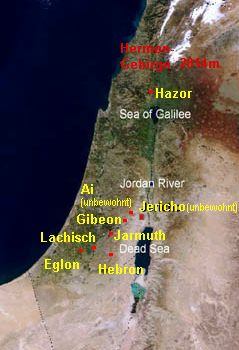
Map with
Jericho, Ai, Hazor, Gibeon and Lachish,
satellite photo |
|
OT
claims:
-- there was a mass of Jewish men, women and
children - and they were handicapped in their
health and did not have much with them - and
this mass are said having performed an invasion
against the big fortresses of Canaan and are
said having won (p.86) and they are said having
needed appr. 10 years for this, according to the
Bible this is said having happened from 1230 to
1220 B.C. (p.89)
-- the book of Joshua claims when the rule would
be observed well, so there will fail no victory
(p.110)
-- claimed occupied cities are Jericho, Ai,
Gibeon, Lachish and Hazor (p.86).
The composed myths and stories about an
Israelite past are compiled to one single
military campaign under Joshua (p.106), and the
whole invasion with mass murder is said having
happened with the blessing of God (p.107).
|
The alleged fall of Jericho
OT claims:
-- Joshua is said having performed one successful siege
after the other
-- first it is said that Joshua had taken the bridge head
of Jericho: When the mass was crossing Jordan river, two
spies are said having been sent to Jericho evaluating the
situation and returning that a whore Rahab had informed
them that whole Jericho would be very afraid of the future
Jewish invasion (p.87)
-- it is said that crossing the Jordan river was no
problem, and the Ark of the Covenant is said having borne
in advance of the
mass of the people
-- it is said that after 7 days of siege the Israelite war
trombones had provoked a fall of the strong walls of
Jericho (Jos. 6) (p.87).
The alleged fall of Ai bei
Bethel
OT claims:
-- as a next town Ai bei Bethel is said having been sieged
(p.87-88) with a double tactic: Joshua is said having
installed a big military camp in the East and a little one
in the West, so the men of Ai had stormed against the big
camp, and they are said having pursued the Jews up to the
desert
-- then the little part of the Jewish army is said having
occupied the town of Ai from the West without any fight
putting fire on the whole town
-- then Joshua is said having slaughtered all inhabitants
of Ai, having collected all cattle and prey, and Joshua is
said having hanged the king of Ai on a tree (Jos. 8,1-29)
(p.88).
The alleged panic in Canaan
OT claims:
There is said that after this panic broke out in whole
Canaan (p.88).
The alleged claim of the
Gibeonites that they would not be natives and by this
should not be defeated
The Gibeonites allegedly claim for mercy and are enslaved
by the Jews.
OT claims:
-- Gibeonites in panic living in four towns in the North
of Jerusalem (p.88) (Gibeon, Kephira, Beeroth,
Kiriat-Jearim) (p.97) are said having pleaded for mercy
claiming that they would be foreigners and not natives,
and by this the order of extermination would not be valid
for them, and Joshua is said having agreed to this (p.88)
-- but then there is said that it was stated that the
Gibeonites were natives and Joshua is said having enslaved
the Gibeonites for ever to "woodcutters and scoops" (Jos.
9,27) (p.88).
The alleged counter coalition
against the alleged Jewish invasion

Map with Jericho,
Ai, Gibeon, Jarmuth, Lachish, Eglon, Hazor
and the Hermon mountains (2814m)
|
|
OT claims:
-- there had been a counter coalition under the
king of Jerusalem, Adoni-Zedek, with the king of
Hebron and with the kings in the Western highlands
(Jarmuth, Lachish
and Egon)
-- the Canaanites are said having unified their
armies at the central place of Gibeon
-- the Canaanite army is said having fled in panic
to the steep mountain crest of Beth Horon in the
West, and God is said having rained big "hail
stones" on the Canaanite armies, so by the hail
stones were more deaths to deplore than by the
fights (Jos. 10,11)
-- Joshua is said having pleaded to God before
sunset keeping the sun without movement winning
time for the killing of all enemies (p.88)
-- then it's said that in fact the sun made no
movement during a complete day, and by this God
had helped Israel (Jos. 10, 13-14)
-- the fled kings are said having been seized and
executed (p.89).
|
The alleged big stone at the
entrance of the cave of Makkeda
OT claims:
-- five Canaanite kings (king of Jerusalem, of Hebron, of
Jarmuth / Jarmut, of Lachish and of Eglon) are said having
fled of Joshua's troops to a cave near Makkeda
-- Joshua is said having received the report that the five
kings had hidden themselves in the cave
-- then Joshua is said having put big stones closing the
entrance of the cave locking the cave until all enemies of
the region were killed
-- after the population had been allegedly killed, Joshua
is said having ordered to hang all five kings on five
trees
-- in the evening Joshua is said having ordered to bring
down the dead bodies of the kings throwing them into the
cave, and then the cave is said having locked with stones
again "up to the present day" (Joshua 10, 16-27) (p.106).
[The place where should be the cave of Makkeda cannot be
found. In Ethiopian language the word Makkeda is the word
for "queen"].
The
alleged further destruction in the South of Israel
Palestine
OT claims:
Under Joshua the Jewish warriors are said
having destroyed all towns of southern Canaan and occupied
the southern region (p.89).
The alleged final battle in the
North of Israel Palestine against the northern coalition
under the command of Jabin of Hazor
OT claims:
-- in the North a coalition of Canaanites
kings under the supreme command of Jabin of Hazor is said
having built a big army against the alleged Jewish murder
invasion against any international law (Jos. 11,4)
-- the armies of the Canaanites under
Jabin are said having been confronted with the Israeli army
in Galilee on an open field
-- Joshua's warriors are said having
completely destroyed the north Canaanite troops
-- then Joshua is said having occupied
Hazor and put fire on the whole city, the most important
city of Canaan, according to the OT "the main town of all
kingdoms" (Jos. 11,10) (p.89).
In this way Israel Palestine is said
having been occupied by the Israelites from the desert in
the South to the snowy mountains of Hermon mountains in the
North, and God had given this land to the Jews. Then the
land is said having been split to the Israeli tribes (p.89).
Documents
and archeology are speaking that occupation under
Joshua is a fake
Book Joshua is a collection
of myths
-- German Bible searchers of 19th century are defining the
book of Joshua as a collection of myths, heroic stories
and local ideas
-- above all Albrecht Alt and Martin Noth mean that the
book Joshua would be a product of aetiological [searching
the origin] tradition with myths about processes of growth
[and destruction] (p.106).
The
faked warlord Joshua is presented like a king
-- the alleged takeover of power for example is described
like an enthronement (Joshua 1, 1-9) (p.110-111)
-- the faked warlord Joshua is said having given a
profession of loyalty (Joshua 1,16-18) that reminds to the
oath of obedience to a king
-- the faked warlord Joshua is said having led a ceremony
to revive the alliance with God (Joshua 8,30-35) as all
kings of Judah have done
-- God is said having ordered to faked Joshua studying day
and night (Joshua 1,8-9) how also king Josia is said
having done (2d book of Kings 23,25) (p.111).
The
order of the towns in the book of Joshua corresponds
with the order of the 7th century B.C.
It seems very strange, but the strategic military aims in
the fake Joshua book correspond with the strategic
military aims of later war of king Josia (p.111):
-- the list with the towns on the territory of the tribe
Judah (book of Joshua 15, 21-62) corresponds exactly to
the development as it was under king Josia. Finkelstein /
Silberman say:
"This list corresponds exactly with the border lines of of
the kingdom of Judah under Joshia's rule." (p.108)
-- and the names of the locations are corresponding almost
exactly with the layout of the settlements of the 7th
century B.C.
-- some of the mentioned places "were only populated in
the last decades of the 7th century B.C." (p.108)
-- so, also the campaign project corresponds with the
situation of the 7th century B.C. (p.108).
-- and also the prescription of northern territories
corresponds to ex North Reich Israel under Assyrian
occupation and the latter Assyrian province [Samaria]
(p.109), since the Assyrian occupation named as "Samerina"
(p.241).
The
documents speak: Canaan in 13th century B.C. was an
absolute Egypt province - and any Jewish invasion is not
possible
-- according to letters of Egypt Pharaohs found in Tell
el-Amarna, Canaan is an Egypt province during the faked
Jewish invasion
-- there was a strict Egypt administration, the capital of
Canaan province was Gaza
-- Egypt garrisons were distributed in all the country at
the strategic hot spots, for example in Beth-Shean in the
South of Lake Gennesaret, or in Joppa (today's Jaffa, a
part of southern Tel Aviv at the coast)
-- in the OT the Egypt dominance over Canaan during the
faked Jewish occupation is concealed
-- the Canaanite rulers themselves hardly had to say
anything corresponding to the Egypt documents (p.90)
-- it can be admitted that Pharaoh Ramesses II did never
relax his control over Canaan because his military forces
were one of the strongest of Egypt history and his goal in
foreign affairs was very high
-- upheavals were answered with Egypt troops immediately,
and they could come fast by the well prepared road along
the Mediterranean Sea between Egypt and Canaan (p.91).
The impossibilities of a
Jewish invasion in Canaan in 13th and 12th century B.C.
-- it's proved that there was never any exodus under
Moses, so there is the question, how had been a conquest
(p.86)
-- Egypt is said having been passive during the Jewish
invasion which also seems impossible (p.92)
-- Egypt documents never mention any Jewish invasion
nowhere, but such an invasion surely had been mentioned
[in such an important territory like Canaan] when it had
been executed (p.92)
-- the only source mentioning the name of "Israel" in the
13th century is a stele of Pharaoh Meenptha (1235-1224
B.C.) where is indicated a victory against the Israelites
(p.92).
Archeology speaks: There were
no city walls nowhere in Canaan in 13th century
-- the Canaanite towns of these relevant times had
fortified administration seats of the leading ruling class
with the ruling family and their administrators, with
palace, temple complex, and with some public buildings
-- the Canaanite towns themselves had no city walls
-- the farmers were dispersed in little villages
-- all sieges and city walls in Old Testament are a fake,
so (p.90).
There can be presumed the reasons for the missing of city
walls in Canaan of these times in 13th century B.C.:
-- perhaps because of the military dominance of Egypt, so
it was considered that a construction of city walls would
not be necessary (p.90-91)
-- perhaps because of high taxes for Egypt, so the local
rulers had no means for the construction of city walls any
more
-- or perhaps Egypt forbade the construction of city walls
controlling more the population (p.91).
According to archaeological findings there was a high
Egyptian influence and control in Canaan for a long time
after the faked Jewish conquest until came the time of
Ramesses VI at the end of the 12th century B.C. (p.92).
Findings of statues
and hieroglyphs at Beth-Shean [Greek: Scythopolis]
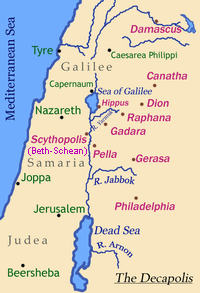
Map of Decapolis
in the Middle East with Scythopolis / Beth Shean
|
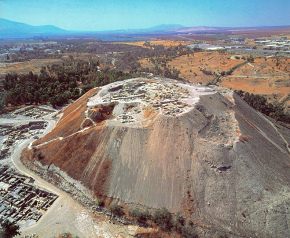
 Beth-Shean
/ Scythopolis: a part of the high hill of ruins
(tell) Beth-Shean
/ Scythopolis: a part of the high hill of ruins
(tell)
|
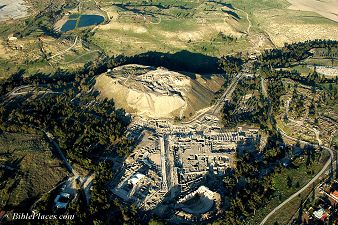
 Beth-Shean / Scythopolis: there is a high and
a lower hill of ruins (tell), see:
www.bibleplaces.com.
Beth-Shean / Scythopolis: there is a high and
a lower hill of ruins (tell), see:
www.bibleplaces.com.
|
"Christian" religious schools, priests, pastors and layman
preacher mostly mean that such town hills should not be
taken earnest. They are going on claiming that the letters
in the Bible are right...
In the 1920s there was excavated an Egypt fortress in Beth
Shean [also: Beth Shan, Greek: Scythopolis] (p.91). The
findings were statues with texts in hieroglyphs from the
time of the Pharaohs
-- Sethos I (1294-1279 B.C.)
-- Ramses II (1279-1213 B.C.)
-- Ramses III (1184-1153 B.C.) (p.92).
[Conclusion:
These findings are absolute proofs for a strong Egypt
dominance in the region in this time, and in other hills
of ruins more such fortresses can be found].
Excavations
in Jericho (hill of ruins Tell es-Sultan) say: there was
no population in 13th century B.C.
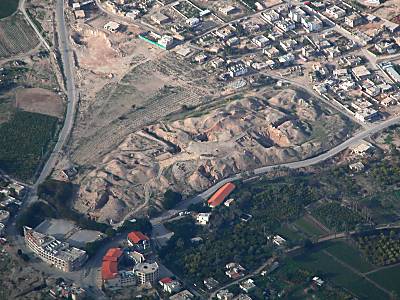 The hill of ruins (tell) of Jericho,
see: www.bibleplaces.com
The hill of ruins (tell) of Jericho,
see: www.bibleplaces.com
The excavations at the hill of ruins (tell) of Jericho
(also called: Tell es-Sultan, er-Riha, Eriha, Yeriho) give
the following information:
-- for the 14th century B.C. there can be proved only a
little village without any fortification
-- for the 13th century there is no trace of any
population at all, the spot was without population
-- and traces of destruction are missing also (p.96).
So, according to Finkelstein / Silberman, the trombones
which allegedly have destroyed the city walls of Jericho,
are a big lie (p.96).
[No city walls and no population were there: That is a
double lie].
Archeology
says about Ai (hill of ruins called Chirbet et-Tell):
there was no population in 13th century B.C.
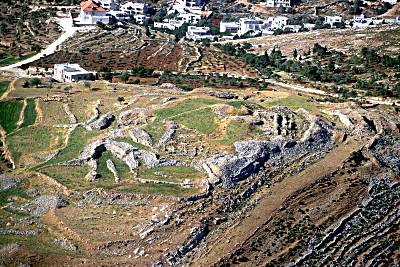 The hill of ruins (tell) of Ai, Chirbet
et-Tell, see: www.bibleplaces.com
The hill of ruins (tell) of Ai, Chirbet
et-Tell, see: www.bibleplaces.com
-- the excavations of Jewish woman archaeologist Judith
Marquet-Krause 1933-1935 showed ruins of a huge town from
Early Bronze Age in appr. 2300 B.C.
-- from Late Bronze Age during the alleged Jewish invasion
was not found anything, the location was without
population
-- and new excavations in the 1960s have not brought
anything new (p.96).
According to archaeological excavations Jericho and Ai had
no population during the conquest of the Jews in Canaan
(p.96).
Bible-believing archaeologist Albright means that the
alleged events of Ai had happened in Bethel near Ai
(p.97).
Excavations at the four
Gibeonite towns which allegedly pleaded for protection:
Gibeon, Kephira, Beeroth, Kiriat-Jearim: there was no
population
-- the scholars can find an agreement that the excavation
in the village ed-Dshib in the North of Jerusalem would be
the hill of Gibeon
-- then remnants of Middle Bronze Age and of Iron Age are
found, but nothing is found of Late Bronze Age. So Gibeon
in these times also had no population
-- in the other three towns populated allegedly by the
Gibeonites during the Late Bronze Age (Kephira, Beeroth
and Kiriat-Jearim) there cannot be found anything either
of Late Bronze Age (p.97).
The stone of the cave of
Makkeda: that's nothing more than a rumor
One rumor indicates that in a cave of Makkeda had been
captivated 5 kings of the Old Ages with a stone (Joshua
10, 16-27).
It can be that a big stone before an entrance of a cave
has impressed the population all the time. And according
to the Bible researchers Albrecht Alt and Martin Noth it
can be that there are created new heroic stories and
rumors about such a stone (p.106).
[There is nothing more about this stone and it's cave,
neither a stone, and neither a cave].
More
excavations: towns without populations and fire storms
There are more excavations and more towns without
population are found, but also traces of fire storms are
found. The stated fire storms are dated in a range of time
of 100 years. But there cannot have been an invasion of
Joshua of over 100 years, but here were other culprits
doing their work. So, Jewry has never committed any
genocide under Joshua, and this is principally only good
news.
But there are stated many fire storms in Canaan with ash
layers with fallen walls and burnt wooden beams, but there
are no city walls (p.94). The ruins of the burnt cities
are building a "layer of destruction" with a thickness of
1 to 2 meters (p.105).
x
|
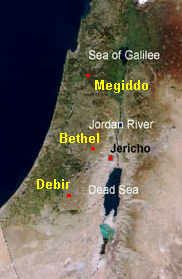
Map with Megiddo
and Debir, satellite photo
|
Excavations in Megiddo in Jezreel plain
indicate that there was no population
According
the excavations Megiddo had a territory of 10 hectares
(p.95). Remnants of Middle Bronze Age and of Iron Age are
found, but from Late Bronze Age is not found anything
(p.97).
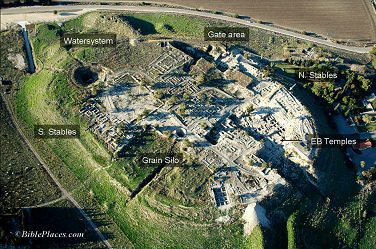
 The hill of
ruins (tell) of Megiddo
Excavations
in Debir (at the Tell Bet Mirsim) show a fire storm
Between 1926 and 1932 the archaeologist
and language researcher William Foxwell Albreight is
leading excavations at the Tell Bet Mirsim south west of
Hebron:
-- the Tell Bet Mirsim is identified as
the town of Debir
-- in the OT there is mentioned a Jewish
occupation three times (Joshua 10, 38-39; 15, 15-19) and
in the book of Judges 1,11-15
-- according to the excavations Debir
was a little, poor town without city wall
-- according to Albright a big fire
storm destroyed the whole town in 1230 B.C.
-- rough potsherds are identified by
Albright as Israelite
-- and by this Albright means that the
invasion of the Jews had really happened (p.94).
Excavations
at the Arab village Betin: Lus becomes Bethel: and there
was another fire storm
-- the location near Betin is identified
as Bethel
-- archeology states that Betel was a
Canaanite town with population during the Late Bronze Age
-- at the end of the 13th century Bethel
was destroyed by a fire storm, and during the Iron Age I
it was populated by another population as it seems (p.94).
Archaeologist Albright means that the
book of Judges 1,22-26 and the conquest would be fulfilled
by this: The Canaanite town Lus had been occupied by
relatives of Joseph and the name had been changes into
Bethel (p.94).
But it's not necessary that Bethel has
been destroyed by Israelites (p.97).
around 1170 B.C.
Excavations
in Lachish (hill of ruins Tell ed Duwer): and there was
a fire storm again
The hill of
ruins (tell) of Megiddo
Excavations
in Debir (at the Tell Bet Mirsim) show a fire storm
Between 1926 and 1932 the archaeologist
and language researcher William Foxwell Albreight is
leading excavations at the Tell Bet Mirsim south west of
Hebron:
-- the Tell Bet Mirsim is identified as
the town of Debir
-- in the OT there is mentioned a Jewish
occupation three times (Joshua 10, 38-39; 15, 15-19) and
in the book of Judges 1,11-15
-- according to the excavations Debir
was a little, poor town without city wall
-- according to Albright a big fire
storm destroyed the whole town in 1230 B.C.
-- rough potsherds are identified by
Albright as Israelite
-- and by this Albright means that the
invasion of the Jews had really happened (p.94).
Excavations
at the Arab village Betin: Lus becomes Bethel: and there
was another fire storm
-- the location near Betin is identified
as Bethel
-- archeology states that Betel was a
Canaanite town with population during the Late Bronze Age
-- at the end of the 13th century Bethel
was destroyed by a fire storm, and during the Iron Age I
it was populated by another population as it seems (p.94).
Archaeologist Albright means that the
book of Judges 1,22-26 and the conquest would be fulfilled
by this: The Canaanite town Lus had been occupied by
relatives of Joseph and the name had been changes into
Bethel (p.94).
But it's not necessary that Bethel has
been destroyed by Israelites (p.97).
around 1170 B.C.
Excavations
in Lachish (hill of ruins Tell ed Duwer): and there was
a fire storm again
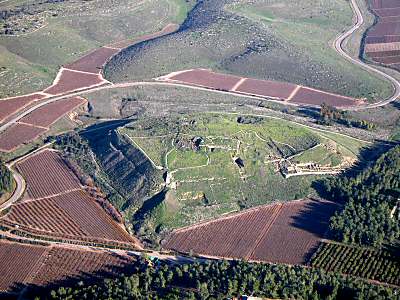 The hill of ruins (tell) of Lachish,
see: www.bibleplaces.com
The hill of ruins (tell) of Lachish,
see: www.bibleplaces.com
In the 1930s British archaeologists are
excavating a big town of Late Bronze Age (p.94) with a
layout of 10 hectares (p.95), and again is found the
trace of a fire storm. For the archaeologists the Bible
text of Joshua 10,31-32 is fulfilled by this (p.94).
The impressive Canaanite town of Lachish was burnt down
and then given up (p.105). The date of the fire storm is
proved for around 1170 B.C. because there are peaces of
metals in the "layer of destruction" - probably from the
main town gate - with the inscription of Pharaoh Ramses
III who had it's governance from 1184 to 1153 B.C.
(p.105).
But it's not necessary that Lachish has been destroyed
by Israelites (p.97).
Excavations in Hazor (hill
of ruins Tell el-Waggas): and once again there was a
fire storm
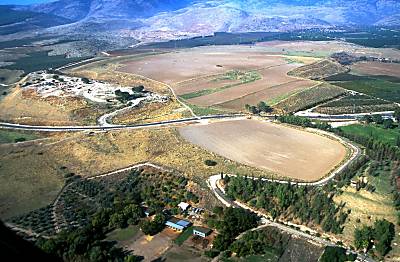
The hill of ruins (tell) of Hazor (Tell
el-Waggas), see: www.bibleplaces.com |
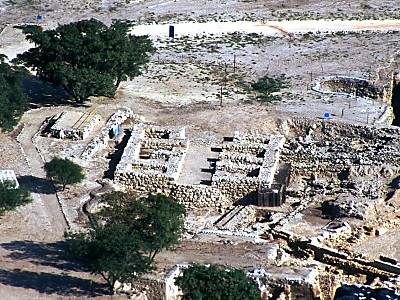
Hazor: a six chamber gate was found, but there
is the question who built it
|
In 1956 the Jewish archaeologist Yigael Yadin begins
with his excavation of Hazor (p.94). According to Joshua
11,20 "this was the capital of all these kingdoms" in
Canaan (p.94-95). Can be confirmed this?
Tell el-Waggas is a huge tell:
-- according to archaeological research Hazor was the
greatest town of Canaan in the Late Bronze Age, 80
hectares was the layout (p.95)
-- according to the archeology the climax of the
development in Hazor was in the European Mid Bronze Age
(2000-1550 B.C.), but the boom of the town lasted far
into the Late Bronze Age
-- there are many temples and huge palaces excavated
-- the palace is excavated in the 1990s under the
leadership of archaeologist Amnon Ben-Tor from Hebrew
University [Jerusalem] (p.95)
-- there are cuneiform findings indicating an archive,
and among others there is mentioned the king of Hazor:
Ibni, which is mentioned in the Mari archives as Ibni
Addu
-- Finkelstein / Silberman presume that the name stays
in connection with the king of Hazor Yabin, eventually
this was a dynasty (p.95).
And then was a fire storm and the destruction:
-- in the 13th century B.C. the boom of the time finds a
sudden end, the town is destroyed and put on fire, the
mud bricks of the palace walls are burnt in red and are
standing today yet with a height of 1.8 meters (p.95)
-- the town is destroyed relatively soon, at about 1350
B.C., and this is provable with ceramic findings: The
ceramics found don't have yet the typical form of the
late 13th century (p.105)
-- god's statues are beheaded and broken (p.104).
But it's not necessary that Hazor has been destroyed by
Israelites (p.97).
And then was a poor population:
After some time of being lost a poor village was found
in the center of this huge field of ruins which can be
proved with potsherds similar as in the early Israeli
villages in the highlands of the West Bank more to the
South (p.95).
Other excavations in other
towns of the alleged conquest: Arad, Hesbon a.o.: more
fire storms
Also in the hills of
ruins of Arad, of Hesbon etc. are found remnants
of the Mid Bronze Age and of the Iron Age, but
nothing can be found of the late Bronze Age
(p.97) resp. there are traces of fires, but
there is no obligation that Jews were the
culprits who put the fires (p.97).
Villages are not
destroyed
Another mystery is the fact that some spots are
totally destroyed, but others not, without any
destruction (p.107). The majority of the
villages in Canaan are not burnt. And the
villages are not left either (p.120).
|
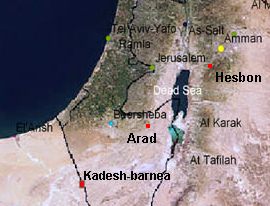
Map with
Kadesh Barnea, Arad, and Hesbon, satellite
photo
|
Clearance of the
contradictions: The real culprits were wild pirates
("maritime nations") exploiting the peace
-- there were no city walls in Canaan
(p.96)
-- and the peace between Egypt and the
Hittites in combination with a hyperextention of the
borders gives way to the negative ideas of pirates looting
the towns (p.99-100).
In the beginning of the 13th century
B.C. both Empires of the region, Egypt and Hittites, have
a great military battle with a draw between the Egypt
Pharaoh Ramesses II and
the Hittite king Muwattalli
on Orontes river
(western Syria, today's Lebanon).
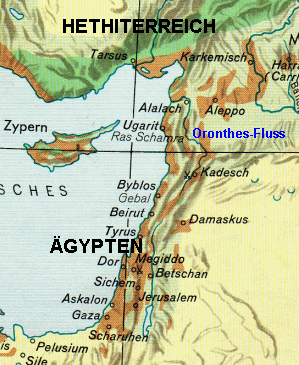
 Map with the
Empires of Egypt and the Hittites with Orontes river as
borderline: Jerusalem did not exist in
these times yet.
Map with the
Empires of Egypt and the Hittites with Orontes river as
borderline: Jerusalem did not exist in
these times yet.
There is an agreement between the successor of
Muwattalli, Hattuschili
III and Ramesses
II with a peace treaty "for ever" (p.99), and
Ramesses even is taking a Hittite princess as his wife,
as a symbol for the peace treaty (p.100).
In the region of eastern Mediterranean until far into
the 13th century B.C. there are governing Egypt in the
South (p.97) with the capital of No-Amon, today Luxor (p.101), and
in the North are governing the Hittites with the
borderline in Syria (p.97) with their capital of Hattusha in the East
of the today's Ankara (p.101). It could be that the
trade power of Mycenae
(Peloponnese of Greece) has used the situation for
attacks. This Mycenae is managing the whole trade in the
eastern Mediterranean under the observation of the big
powers, altogether with the strategic island of Cyprus
(p.100).
There is a dramatic change of the societies. The heavy
crises is devastating the kingdoms of the Bronze Age
(p.97) and there are new kingdoms coming up (p.98). The
precise cause for the collapse of the Reichs of the
Later Bronze Age is not known. The source of violence is
not clear. [It was surely not a Jewish invasion after 40
years of migration in the desert].
Several hypothesis:
-- possible is a war about essential land strips and
farmer's villages
-- or harassed farmers and shepherds have attacked the
big towns (p.104)
-- or there were invasions from different sides
-- or the society collapsed
-- or there was a civil war (p.105).
There was mass pillage and
setting fire in the whole region of eastern
Mediterranean Sea
-- scholars mean that the fires were put by violent
maritime nations in combination with an invasion on the
land (p.101)
-- there had been huge maritime nations having made an
alliance with the Philistines, Sicels, Shekelesh,
Denyens, and with the Weshesh
-- according to drawings and paintings these maritime
nations are foreign ethnic groups, some have helmets
with horns, others have headdresses with feathers on
their heads (p.102)
-- there are also reports from Ugarit [a city state in
northern Syria on the Mediterranean coast] and also from
Egypt are reports from the early 12th century mentioning
such looters (p.101).
Other scholars mean
-- that there had been an easy alliance of pirates and
rootless souls
or
-- there had been a change of climate and foreigners
from the North had been driven away by this and had
arrived in the Mediterranean (p.103) provoking a forming
of wild groups of pirates and looters (p.104)
or
-- the whole society of eastern Mediterranean had
suffered an over specialization and a block of
development and could have collapsed by this (p.104)
provoking the forming of wild pirates and looters
(p.104).
1185 B.C.
Finding of text: Ugarit is in danger by hostile
ships and pillage
The last king of the Ugarit, Hammurabi, reports to the
the king of Alashiya (today Cyprus) claiming hostile
ships and pillages. Hammurabi warns that Ugarit will not
be able to defend itself because his troops were in the
land of the Hittites and his boats in Lycia (p.102).
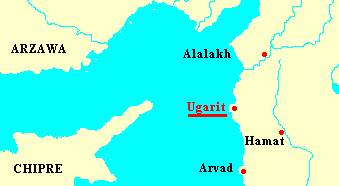 Map with Ugarit at the upper
Mediterranean coast opposite to Cyprus.
Map with Ugarit at the upper
Mediterranean coast opposite to Cyprus.
| Inscriptions at the
temple in Medinet Habu, built under Ramses III |
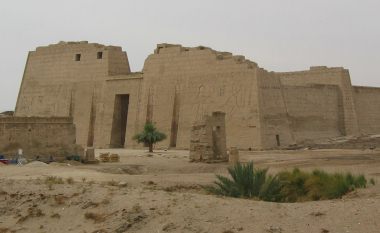
 The temple
in Medinet Habu, built under Ramses III The temple
in Medinet Habu, built under Ramses III
|
|

The temple complex in Medinet Habu, built
under Ramses III, air photo
|
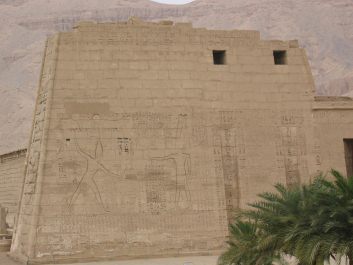
 Inscription in the temple wall of the temple of
Ramses III in Medinet Habu, left side of the
wall
Inscription in the temple wall of the temple of
Ramses III in Medinet Habu, left side of the
wall
|

 Inscription in the temple wall of the temple of
Ramses III in Medinet Habu, middle and right
side of the wall
Inscription in the temple wall of the temple of
Ramses III in Medinet Habu, middle and right
side of the wall
|
These illustrations of the fights show
the strong ethnic difference of the invaders and the
Egyptians. Some have helmets with horns, others have
headdresses with feathers on their heads (p.102)
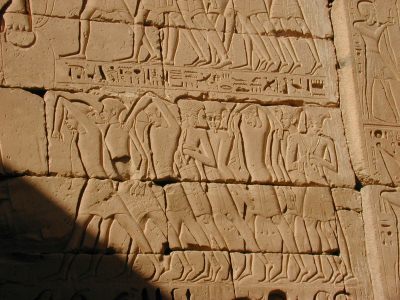

 Philistines with
feathers on their heads. Illustration in the temple in
Medinet Habu, built under Ramesses III
Philistines with
feathers on their heads. Illustration in the temple in
Medinet Habu, built under Ramesses III
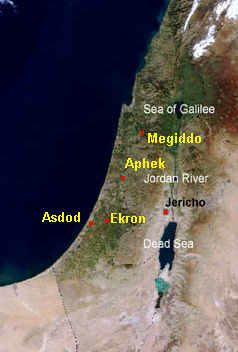
Map with
Ashdod, Ekron, Aphek (in the coastal plain)
and with Megiddo, satellite photo
|
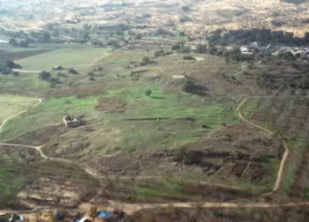
Ashdod: the hill of ruins (tell) is almost
invisible by the fields

The hill of ruins of Ekron (Tell Miqne) is only
some meters higher than the fields
|
-- and then Ashdod is destroyed after
the times of Ramses III by a fire
-- in 12th century B.C. new towns are
founded on the ruins of Ashdod and Ekron by Philistine
immigrants, and the towns again are wealthy, with a new
material culture, but in a completely new Aegean inspired
style in architecture and pottery (p.104).
about 1230 B.C.
Fire
storm in Aphek in the coastal plain
(p.104-105)
This fire storm is happening around the
year 1230 B.C. This is stated by archaeological findings:
In the "layer of destruction" is found a letter in
cuneiform writing mentioning Ugaritian and Egyptian
officials who can be dated precisely with other sources
(p.105). The letter of Aphek in cuneiform writing
describes a vital corn trade between Ugarit and Egypt
(p.105).
1140
B.C. appr.
Fire storm in the
town of Megiddo
-- main witness of this fire
storm at the end of Late Bronze Age are burned
mud bricks
-- the "layer of destruction" with all it's
rubble has got a thickness of 1.8 meters
(p.105)
-- the evidence for the date of about 1140
B.C. is a metal socket of a statue found in
the layer of destruction with the name Ramses
IV who was governing 1143 to 1136 B.C.
(p.105).
On the countryside life is going on as usual
(p.179).
|

 The hill
of ruins (tell) of Megiddo, see:
www.bibleplaces.com The hill
of ruins (tell) of Megiddo, see:
www.bibleplaces.com |
1130 B.C.
The big Empires in the
eastern Mediterranean are all destroyed
The changes in the region are dramatic,
and also Egypt is affected:
-- Egypt is a shadow of it's past and a
big part of the Empire is destroyed
-- the Hittite Empire with its capital
Hattusha is in ruins
-- Mycenaean world with it's center of
Crete is destroyed
-- trade with Cyprus with it's copper
mines is stopped
-- Canaanite ports are only ruins, also
the great sea power of Ugarit
-- Megiddo and Hazor are fields of ruins
(p.101).
Stop the bad fantasies: There
is a logic of time: 100 years of Joshua campaign are not
possible
It's proved that the towns of Hazor,
Aphek, Lachish and Megiddo are destroyed within 100 years.
And it's impossible that Joshua has made an invasion over
100 years (p.105).
[Conclusion: The faked war
hero Joshua has got ruins that are not from him
The Jewish priests of the 1 God movement
who have written the Old Testament, they meant that the
ruins of the former times could be used for the creation
of a faked Jewish war hero. And many believed it].


The hill of ruins (tell) of Megiddo






















